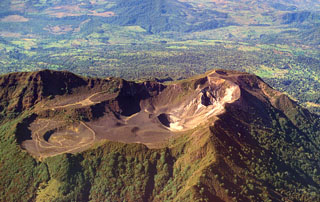Report on Turrialba (Costa Rica) — 28 June-4 July 2017
Smithsonian Institution / US Geological Survey
Weekly Volcanic Activity Report, 28 June-4 July 2017
Managing Editor: Sally Sennert.
Please cite this report as:
Global Volcanism Program, 2017. Report on Turrialba (Costa Rica) (Sennert, S, ed.). Weekly Volcanic Activity Report, 28 June-4 July 2017. Smithsonian Institution and US Geological Survey.
Turrialba
Costa Rica
10.025°N, 83.767°W; summit elev. 3340 m
All times are local (unless otherwise noted)
OVSICORI-UNA reported that during 29 June-4 July seismicity at Turrialba was characterized by low-to-medium amplitude tremor, and a small number of low-amplitude volcano-tectonic and long-period events. Plumes of water vapor, magmatic gases, and occasional ash rose as high as 1 km above the West Crater fumaroles. Incandescence from the main crater was recorded at night. Minor ashfall and a sulfur odor was reported in areas of San José including Rancho Redondo, Goicoechea, Moravia, San Pedro Montes de Oca, and Guadalupe.
Geological Summary. Turrialba, the easternmost of Costa Rica's Holocene volcanoes, is a large vegetated basaltic-to-dacitic stratovolcano located across a broad saddle NE of Irazú volcano overlooking the city of Cartago. The massive edifice covers an area of 500 km2. Three well-defined craters occur at the upper SW end of a broad 800 x 2200 m summit depression that is breached to the NE. Most activity originated from the summit vent complex, but two pyroclastic cones are located on the SW flank. Five major explosive eruptions have occurred during the past 3500 years. A series of explosive eruptions during the 19th century were sometimes accompanied by pyroclastic flows. Fumarolic activity continues at the central and SW summit craters.
Source: Observatorio Vulcanologico y Sismologico de Costa Rica-Universidad Nacional (OVSICORI-UNA)

